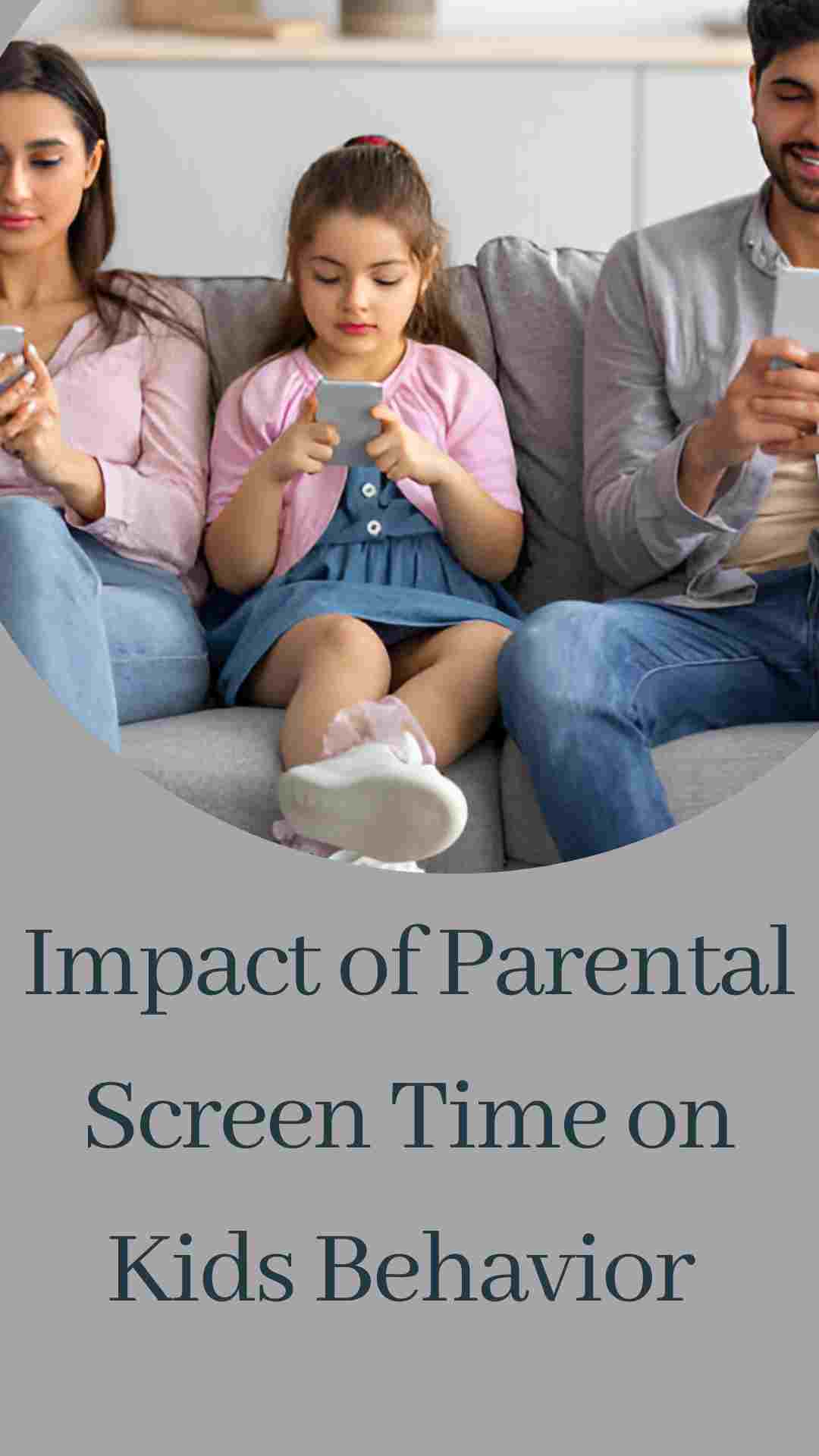The Impact of Parental Screen Time on Kids’ Behavior
It’s a cozy evening, and the family is gathered in the living room. The toddler is playing with blocks on the floor, the preschooler is flipping through a picture book, and the parents? Well, their eyes are glued to their phones. A notification buzzes, a quick swipe, then a scroll. Minutes turn into hours, and the glow of the screen becomes the dominant light in the room. Moments like these are becoming increasingly common in our tech-driven world, and they may have an important observation: the impact of parental screen time on kids’ behavior.
Research shows that children are deeply affected by their parents’ actions, both big and small. Whether it’s checking emails during dinner, scrolling through social media at the park, or binge-watching shows after bedtime, our interactions with technology don’t go unnoticed. Children are keen observers, and their behavior often mirrors what they see. So, how does parental screen time shape their emotional well-being, social skills, and overall development?
Let’s look at the ripple effects of our digital choices on the little eyes that are always watching—and analyze what we can do to create healthier techniques and boundaries for our families.

The Impact of parental Screen Time on Kids’ Behavior
Children are natural imitators. They don’t learn by what we say but by what we do. When a parent is consistently on their phone during family time, a child might begin to associate screens with normal behavior. They may think, “If Mom or Dad is always on their phone, it must be important.” This often leads to an increased desire for screens among children, sometimes resulting in tantrums when those devices are restricted.
One of my friends, Florence, often found herself scrolling through Instagram during meals. Soon, her 6-year-old son began demanding a tablet during dinner, claiming it was “boring to eat without it.” She realized that her behavior had unintentionally set the standard for her child’s expectations.
1. Emotional Disconnect
My neighbor’s daughter excitedly showed her latest drawing to her only to receive a distracted “That’s nice, honey” without even a glance. This lack of attention can create a sense of emotional disconnect. Children crave validation and engagement. When they don’t receive it, they may act out to grab attention or, conversely, withdraw and become less communicative.
Kindly check:
2. Increased Behavioral Issues
When parents are distracted by screens, supervision often takes a backseat. This lack of attention can lead to risky behavior in children. Without consistent guidance, kids may push boundaries, seeking limits that parents are too distracted to enforce.
Positive Impacts of Parental Screen Time on Children

1. Educational Role Modeling
Using screens for productive purposes—such as reading e-books, researching, or engaging in online learning—set a positive example for children, demonstrating that screens can be tools for knowledge and growth. For example, a mother learning a new skill through online tutorials (e.g., baking, painting) can inspire her child too.
2. Enhanced Communication
Parents can use screens to stay connected with their children and relatives through text messages, video calls, or sharing family updates. This helps to maintain bonds during work hours or when physically apart. Regular video calls with grandparents teach children the importance of staying in touch with loved ones.

3. Facilitating Quality Time
Screen time can be a shared activity, such as watching a family movie, and educational apps together, or playing age-appropriate video games. This fosters connection and bonding.
4. Promoting Family Creativity
Screens can enable parents to search creative activities with their children, such as crafting digital photo albums, designing family videos, or using art apps to create projects together.
5. Encouraging Curiosity and Learning Together
Parents can use screens to get new topics with their children, such as documentaries, virtual museum tours, or interactive science experiments. This shared curiosity fosters a love of learning and discovery.
6. Fostering Cultural Awareness
Through screens, parents can expose their children to diverse cultures, languages, and traditions. Watching international content, engaging in language-learning apps, or exploring global events online broadens a child’s worldview.
7. Staying Informed About Children’s Interests
Through screens, parents can keep up with trends in their child’s world—whether it’s a new game, music, or popular online content. Understanding these interests strengthens their ability to connect with their kids.
8. Encouraging Collaborative Problem-Solving
Parents and children can use screens to tackle challenges together, such as researching for a school project, solving puzzles in an app, or troubleshooting technical issues—building teamwork and critical thinking skills.
9. Career Inspiration
Parents working on professional tasks like coding, graphic design, or content creation can inspire their children to develop future career paths.
A dad designing a website at home may encourage his child to take an interest in technology.
Negative Impacts of Parental Screen Time
On the flip side, excessive or inappropriate parental screen use can lead to undesirable consequences for children.

1. Decreased Emotional Connection
When parents are constantly on their devices, children may feel ignored, leading to emotional insecurity or acting out for attention. A mother scrolling through social media during dinner might miss cues about their child’s feelings or stories, making the child feel unimportant. My sister complained that her toddler threw her phone into the sink out of frustration because she wasn’t engaging with him.
2. Increased Behavioral Issues
Children may imitate the screen habits of their parents, leading to overuse or mimicry of distracted behavior. They might also become aggressive or withdrawn when seeking attention from unavailable parents.

3. Poor Social Development
Parents absorbed in screens may not model essential social behaviors, such as eye contact or active listening, leaving children with limited interpersonal skills. A father constantly texting during playdates unknowingly taught his child to look at their tablet instead of interacting with peers.
4. Language Development Delays
Kids rely on interaction and conversation to develop language. Parents glued to devices miss opportunities to talk, read, or respond to their children, which can hinder language skills. A pediatrician reported a case where a toddler had delayed speech because her parent preferred watching videos on their phone during the child’s playtime, limiting verbal engagement.

5. Emotional Outbursts and Anxiety
Children who feel neglected may express their frustration through tantrums, emotional outbursts, or anxiety about their importance in the family. I remembered my son yelling, “Put your phone down, Mommy!” during bedtime stories. He later developed bedtime anxiety thinking I don’t have time for him.

6. Impaired Family Relationships
Excessive screen use reduces the quality of family bonding time, leaving kids feeling disconnected from their parents. A family counselor observed a teenage boy becoming distant from his parents, who often prioritized binge-watching TV over family meals. He felt his parents were uninterested in his life and stopped sharing details with them.
7. Missed Opportunities for Bonding
Family bonding activities like storytelling, board games, or outdoor play may be replaced by screen-focused time, weakening family relationships. Parents who spend evenings on their laptop instead of helping with homework or reading bedtime stories misses valuable bonding moments
8. Weakened Parent-Child Bonds
Meaningful connections are built through quality time and shared experiences. Persistent screen use can erode this bond, making it harder for parents to establish a sense of trust and emotional security with their children.
10. Emotional Distress in Kids
Kids are highly perceptive and often notice when they are not the priority. Parental screen time can make children feel undervalued, which can lead to feelings of frustration, sadness, or even anxiety.
11. Impact on Academic Performance
Children who don’t receive adequate attention and encouragement at home may face challenges in developing focus and motivation, which can affect their academic performance in the long run.
Solutions to Mitigate Negative Impacts
1. Be Mindful of Screen Usage
Awareness is the first step. Parents should monitor their screen time and identify patterns that might affect their interactions with their children. Apps like “Screen Time” or “Digital Wellbeing” can help track usage and set limits.
2. Set Boundaries
Establishing screen-free zones and times can create a healthier environment. For instance, designate mealtimes, family outings, and bedtime as screen-free periods.
3. Prioritize Quality Time
Allocate specific times for focused interactions with your children. Whether it’s reading a bedtime story, playing board games, or simply talking about their day, these moments foster emotional connections that screens cannot replace.
4. Educate Through Action
Show them that screens are tools, not distractions. For example, a parent researching gardening tips online can involve their child in planting flowers, demonstrating how technology can complement real-life activities.
5. Seek Balance
Balance is key. Ensure that screen time is balanced with outdoor play, creative activities, and family bonding. One mother shared how her family adopted a “tech-free Sunday,” dedicating the day to hiking, picnics, and other offline activities.
How to Manage Parental Screen Time Effectively
1. Use Technology to Your Advantage
Leverage apps and tools designed to limit and manage screen use. Apps like “StayFree” or “Forest” can help parents stay accountable while encouraging productivity.
2. Create a Family Media Plan
Develop a family media plan that outlines screen time rules and expectations for everyone. Include age-appropriate guidelines for children and set an example by adhering to these rules yourself.
3. Practice Self-Regulation
Parents should model self-regulation by resisting the urge to check their phones constantly. For instance, silence notifications or use “Do Not Disturb” mode during family time.
4. Engage in Shared Activities
Instead of retreating to separate screens, opt for shared activities. Watch a family movie, cook together, or engage in a DIY project. These shared experiences strengthen bonds while reducing individual screen dependency.
5. Foster Open Communication
Discuss the impact of screen use with your children. Encourage them to express how they feel when you are preoccupied with screens.
As parents, our behavior profoundly shapes our children. Screens are a part of modern life, but their influence should be balanced with intentional, meaningful interaction. The goal isn’t to eliminate screens but to ensure they don’t overshadow our presence.
When we put down our devices, we send a powerful message: “You matter more than any notification.” That’s a lesson no app can teach but one that will resonate deeply with our children forever. That rounds up the topic “The impact of parental screen time on kids’ behavior”.

